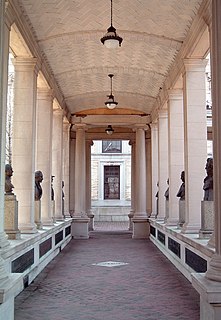
Washington University in St. Louis is a private research university in St. Louis, Missouri. Founded in 1853, and named after George Washington, the university has students and faculty from all 50 U.S. states and more than 120 countries. As of 2017, 24 Nobel laureates in economics, physiology and medicine, chemistry, and physics have been affiliated with Washington University, nine having done the major part of their pioneering research at the university.

Eastern Washington University (EWU) is a public university in Cheney, Washington, with programs offered at campuses in Cheney, EWU Spokane at the Riverpoint Campus and at multiple campus locations throughout the state.

Emory & Henry College is a private liberal arts college in Emory, Virginia. The campus comprises 335 acres (1.36 km2) of Washington County, which is part of the Appalachian highlands of Southwest Virginia. Founded in 1836, Emory & Henry College is the oldest institution of higher learning in Southwest Virginia.

Union University is a private, evangelical Christian, liberal arts university located in Jackson, Tennessee, with additional campuses in Germantown and Hendersonville. The university is affiliated with the Tennessee Baptist Convention and relates to the Southern Baptist Convention.

Colonial Revival architecture was and is a nationalistic design movement in the United States and Canada; it seeks to revive elements of architectural style, garden design, and interior design of American colonial architecture.

Transylvania University, colloquially known as "Transy", is a Christian private university in Lexington, Kentucky. It was founded in 1780 and was the first university in Kentucky. It offers 36 major programs, as well as dual-degree engineering programs, and is accredited by the Southern Association of Colleges and Schools. Its medical program graduated 8,000 physicians by 1859.
Patrick Henry College (PHC) is a private classical liberal arts non-denominational Christian college that teaches Classical Liberal Arts, Government, Strategic Intelligence in National Security, Economics and Business Analytics, History, Journalism, Environmental Science & Stewardship, and Literature located in Purcellville, Virginia. PHC is accredited by the Transnational Association of Christian Colleges and Schools, a national faith-related accrediting organization.

Collegiate Gothic is an architectural style subgenre of Gothic Revival architecture, popular in the late-19th and early-20th centuries for college and high school buildings in the United States and Canada, and to a certain extent Europe. A form of historicist architecture, it took its inspiration from English Tudor and Gothic buildings. It has returned in the 21st century in the form of prominent new buildings at schools and universities including Princeton and Yale.

Charles Henry Niehaus, was an American sculptor.

Pompeo Luigi Coppini was an Italian born sculptor who emigrated to the United States. Although his works can be found in Italy, Mexico and a number of U.S. states, the majority of his work can be found in Texas. He is particularly famous for the Alamo Plaza work "Spirit of Sacrifice" a.k.a. The Alamo Cenotaph, as well as numerous statues honoring Texan figures.

The Hall of Fame for Great Americans is an outdoor sculpture gallery located on the grounds of Bronx Community College in the Bronx, New York City. It is the first such hall of fame in the United States. Completed in 1900 as part of the University Heights campus of New York University, the 630-foot stone colonnade half-encircles the university library and houses 98 bronze portrait busts of a number of prominent Americans. Designed by architect Stanford White, the Beaux Arts structure was donated by Helen Gould, and was formally dedicated on May 30, 1901. New York University was forced to sell the campus in 1973 to the City University of New York and it became Bronx Community College. Though the Hall's renown has itself faded, its architecture remains, and it stands as a secular national shrine not just to great men and women, but to Roman ideals of fame favored at the beginning of the 20th century.

The University of Southern Mississippi (USM), known informally as Southern Miss, is a public research university with its main campus located in Hattiesburg, Mississippi. The Hattiesburg campus is located 70 miles (110 km) north of Gulfport, Mississippi and 105 miles (169 km) northeast of New Orleans, Louisiana. USM is accredited by the Commission on Colleges of the Southern Association of Colleges and Schools (SACS) to award baccalaureate, master's, specialist, and doctoral degrees. The university is classified by the Carnegie Foundation as a "Research University" with "High Research Activity".

Jeffersonian architecture is an American form of Neo-Classicism and/or Neo-Palladianism embodied in the architectural designs of U.S. President and polymath Thomas Jefferson, after whom it is named. These include his home (Monticello), his retreat, a college he founded, and his designs for the homes of friends and political allies. Over a dozen private homes bearing his personal stamp still stand today. Jefferson's style was popular in the early American period at about the same time that the more mainstream Greek Revival architecture was also coming into vogue (1790s–1830s) with his assistance.

The University Club is an eight-story building of the University of Pittsburgh designed by Henry Hornbostel and completed in 1923 that is a contributing property to the Schenley Farms Historic District on the school's campus in Pittsburgh, Pennsylvania, United States. It serves as a faculty club with publicly accessible dining, banquet, and conference facilities, while the upper four floors serve as housing for the families of out-of-town hospital patients.

Midtown is a neighborhood in St. Louis, Missouri. It is located 3 miles (4.8 km) west of the city riverfront at the intersection of Grand and Lindell Boulevards. It is home to the campus of Saint Louis University and the Grand Center Arts District.

Benson Hall is a building in the University of Washington campus. It is home to the chemical engineering department, whose current chair is Professor François Baneyx. The building was named after Henry K. Benson, a faculty member from 1904 to 1954. During this time, he held the position of Chair of Chemistry and Chemical Engineering. Leonard William Bindon and John LeBaron Wright designed Benson Hall.

Henry Jackson Ellicott was an American sculptor and architectural sculptor, best known for his work on American Civil War monuments.


















